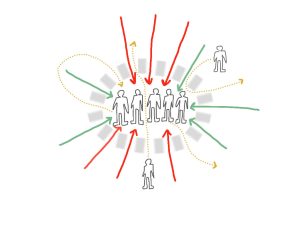Do you really have a team when someone keeps messing with the membership?
One summer, long ago and far away, I was on a softball team. It would be an exaggeration to say I played softball, but I did participate in practices, showed up for games and imbibed of the general post-game joie de vivre (beer). There were a lot of team members like me. It didn’t matter so much if everyone turned out, or if some people didn’t show. Friends of friends showed up. They might play half the season and then disappear. It didn’t matter because it wasn’t about reaching a goal, it was about socializing.
Too many teams have boundaries like that softball team. It’s never clear who will show up, and who the team can count on to play. If you want productive teams, don’t mess with team membership.
Stable Team Membership
The fundamental criteria for a team is stable membership. To be a team, people need to know who the team members are. Weak membership boundaries make it hard for any team to do it’s work. Unstable team membership leads to miscommunication and misunderstanding. And that adds up to time and money. Team members can’t be mutually accountable if they don’t know who is makes up “we” when they commit to deliver.
Downhill Invention, Uphill Analysis
There’s an added hurdle for software teams. The people who write an app build up their mental model of the code as they build the code. It starts simple and grows in complexity. For someone facing an unfamiliar code base, it is a different challenge. They start with something complex. They often build understanding in a piece-meal fashion, as they encounter and work on different parts of the code base. This extends the process of becoming proficient and productive–no matter the level of skill in a particular programming language. When the code base changes during the learning process it takes even longer. With out a robust process to support learning, a newcomer may never become proficient. Which leads to turnover, and starting the learning process a new. (See Downhill Invention, Uphill Analysis in Jessica Kerr’s Origin of Opera post.)
Some organizations assign people who in between projects (or managers) to what ever team seems (operative word “seems”) to need more staff. This is the warm-body theory of staffing, that holds that you can plug a person with roughly the right skills into a team and achieve productivity right away. (There’s a related fantasy, that full utilization is desirable and efficient). The reality is that plugging people into a team creates a revolving door effect and the effort to bring people up to speed slows down productive work (see Brook’s law).
In terms of getting work done (and keeping people engaged) its more effective when people between teams or projects work on their own special projects, attend training, or just take a breather.
The belief that a group can start working at full potential the first week they are together is a fantasy. It’s also a fantasy that teams can function with who ever shows up.








I have suffered from the ever changing teams before. Even trying to implement Agile processes I’ve been forced to gain or lose members.
Just when you get used to the team, who is good at doing what and developed the teams dynamic it is changed.
Better to move the work between teams than members between teams.
You will also experience the similar problems when changing teams quite often.
It leads to peoples frustration and lack of understanding who are ‘we’
“In terms of getting work done (and keeping people engaged) organizations are better off it people who are “in between” work on their own special projects, attend training, or just take a breather.”
Totally agree.
But in the real world, does this actually happen these days? I haven’t seen it in a long time.
Instead, it’s run a very lean time of permanent employees, and plug in contractors continually. A the end of the project, the contractors goes away. Next project – new contractors, and a new learning curve.
The other problem is stable teams with unstable leaders – I’m now on my fourth leader in two and a half years. And we are a team of three! We have established a great collaborative way of working that suits us, and no incoming leader respects or appreciates what we achieve together. And they all shove their way of working down our throats without even asking us our opinion.